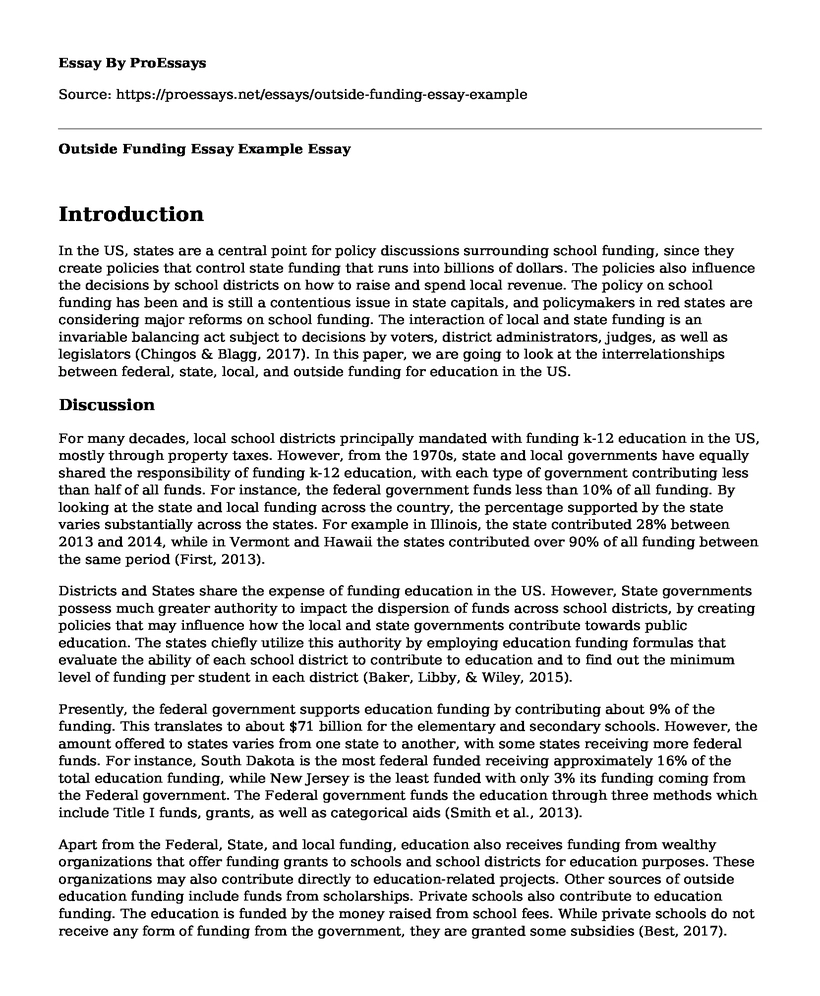Introduction
In the US, states are a central point for policy discussions surrounding school funding, since they create policies that control state funding that runs into billions of dollars. The policies also influence the decisions by school districts on how to raise and spend local revenue. The policy on school funding has been and is still a contentious issue in state capitals, and policymakers in red states are considering major reforms on school funding. The interaction of local and state funding is an invariable balancing act subject to decisions by voters, district administrators, judges, as well as legislators (Chingos & Blagg, 2017). In this paper, we are going to look at the interrelationships between federal, state, local, and outside funding for education in the US.
Discussion
For many decades, local school districts principally mandated with funding k-12 education in the US, mostly through property taxes. However, from the 1970s, state and local governments have equally shared the responsibility of funding k-12 education, with each type of government contributing less than half of all funds. For instance, the federal government funds less than 10% of all funding. By looking at the state and local funding across the country, the percentage supported by the state varies substantially across the states. For example in Illinois, the state contributed 28% between 2013 and 2014, while in Vermont and Hawaii the states contributed over 90% of all funding between the same period (First, 2013).
Districts and States share the expense of funding education in the US. However, State governments possess much greater authority to impact the dispersion of funds across school districts, by creating policies that may influence how the local and state governments contribute towards public education. The states chiefly utilize this authority by employing education funding formulas that evaluate the ability of each school district to contribute to education and to find out the minimum level of funding per student in each district (Baker, Libby, & Wiley, 2015).
Presently, the federal government supports education funding by contributing about 9% of the funding. This translates to about $71 billion for the elementary and secondary schools. However, the amount offered to states varies from one state to another, with some states receiving more federal funds. For instance, South Dakota is the most federal funded receiving approximately 16% of the total education funding, while New Jersey is the least funded with only 3% its funding coming from the Federal government. The Federal government funds the education through three methods which include Title I funds, grants, as well as categorical aids (Smith et al., 2013).
Apart from the Federal, State, and local funding, education also receives funding from wealthy organizations that offer funding grants to schools and school districts for education purposes. These organizations may also contribute directly to education-related projects. Other sources of outside education funding include funds from scholarships. Private schools also contribute to education funding. The education is funded by the money raised from school fees. While private schools do not receive any form of funding from the government, they are granted some subsidies (Best, 2017).
Conclusion
The policy on school funding has been and is still a contentious issue in state capitals, and policymakers in red states are considering major reforms on school funding. Local and State governments equally share the responsibility of funding k-12 education, with each type of government contributing less than half of all funds. Presently, the federal government supports education funding by contributing about 9% of the funding. Apart from the Federal, State, and local funding, education also receives funding from other outside sources.
References
Baker, B. D., Libby, K., & Wiley, K. (2015). Charter School Expansion and Within-District Equity: Confluence or Conflict?. Education Finance and Policy, 10(3), 423-465.
Best, B. (2017). External sources of funding for schools and education. Seced, 2017(34), 6-6.
Chingos, M., & Blagg, K. (2017). Making Sense of State School Funding Policy. Urban Institute. Retrieved December, 4, 2017.
First, D. (2013). How much money does our school district receive from federal, state, and local sources.
Smith, J., Gasparian, H., Perry, N., & Capinpin, F. (2013). Categorical Funds: The Intersection of School Finance and Governance. Center for American Progress.
Cite this page
Outside Funding Essay Example. (2022, Aug 18). Retrieved from https://proessays.net/essays/outside-funding-essay-example
If you are the original author of this essay and no longer wish to have it published on the ProEssays website, please click below to request its removal:
- Paper on Medical Insurance Terms
- Analysis of Business Profitability Paper Example
- Description of Funding Sources of Malaria Prevention and Elimination Program
- Analysis of the Tax and Job Acts of 2017 Essay Example
- Gaining Legal Competency Through Paternity Fraud Cases: A Reflection - Essay Sample
- Impact of IMF, WB on Municipal Finances - Essay Sample
- Essay on ERISA: Regulating Employee Benefits & Insurance Practices







